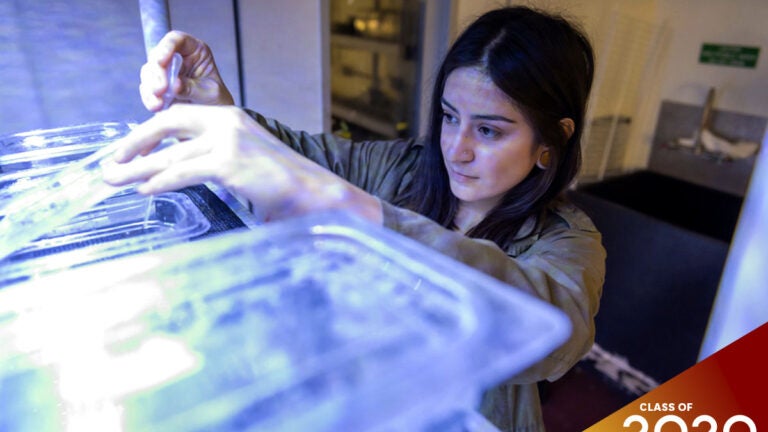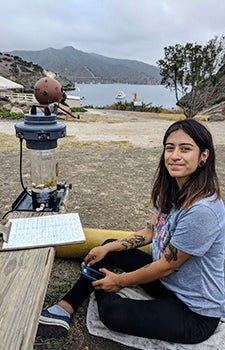
How a student from Chicago ended up protecting sea life through science
The pale-yellow creatures cling to the sides of half-gallon plastic tubs in a dark science lab, their wispy tentacles swaying gently in the water. These dime-size sea anemones might give researchers answers to an important problem: how to protect sea life from climate change.
USC Dornsife College of Letters, Arts and Sciences student Connie Machuca believes in their potential. She studies the genes of these tiny invertebrates, known to scientists as Aiptasia, to understand how they deal with rising water temperatures, differences in the water’s saltiness and other consequences of changing climate. Studying them could reveal new ways to care for endangered underwater ecosystems like reefs that are dying due to coral bleaching.
By figuring out what genes might protect these ocean animals from warmer temperatures or rougher seas, she believes scientists could help them adapt to their new conditions.
Machuca grew up in Chicago and never thought much about the beach before coming to USC Dornsife. But she was drawn to the field of ocean conservation and marine research at USC Dornsife thanks to hands-on work with environmental marine biologist Carly Kenkel, Gabilan Assistant Professor of Biological Sciences. She dove into coral and anemone studies in Kenkel’s lab as a sophomore and never looked back.
As Machuca pursued her degree in environmental studies with a minor in marine biology, the first-generation college student learned how to scuba dive. She traveled across the country to help collect anemone specimens. She conducted her own ocean research at Catalina Island.
“In the beginning, it was hard being away from my family, but I’ve made the most of it and showed them that all their sacrifices were worth it,” she said.
An early passion for science
Machuca gravitated toward environmental issues early in life. She did science projects in school on water quality in Chicago and Lake Michigan. She grew concerned about the effects of pollution and climate change, not only on people but also on plants and animals.
When Machuca came to USC Dornsife four years ago, ocean researcher Jill Sohm, associate professor (teaching) of environmental studies, suggested finding a research position and pointed her to Kenkel, who had just launched her lab.
“Professors here are super understanding when you don’t know something or you come from a background where you don’t have experience,” Machuca said. “I didn’t have any research experience, but I was able to talk to some professors: ‘This is what I’m interested in, what do you think I should pursue?’ Having that relationship outside of lectures was really helpful for me in deciding what I wanted to do.”
First-gen USC student explores climate change and impacts on sea life
As an assistant in Kenkel’s lab, she grew fascinated with how climate change is affecting coral, anemones and similar ocean creatures.

Connie Machuca uses a small pressure chamber to study juvenile kelp at the USC Wrigley Marine Science Center. (Photo: Courtesy of Connie Machuca.)
Studying coral is tricky, though. The finicky creatures need new seawater shipped in regularly and are sensitive to changes in their habitat. Aiptasia, on the other hand, thrive in so many conditions that they’re known as aquarium pests.
Machuca thinks Aiptasia can stand in for coral in research labs. They could help scientists find solutions to the effects of climate change without the challenge of trying to keep their specimens alive.
A future career in ocean research and teaching
Machuca’s passion for marine research has taken her far beyond the basement lab at USC. She traveled to Florida last summer to collect anemone specimens using a SURF grant from USC Dornsife. Another summer, kelp research took her to Catalina, with funding from the National Science Foundation. She earned her scuba certification last year and now is taking a scientific diving course offered at the USC Wrigley Institute for Environmental Studies, based at USC Dornsife, so she can conduct underwater research in graduate school and beyond.
Machuca also participated in a naturalist training program through USC Sea Grant, learning about California’s natural history with a focus on coastal areas. The experience helped her teach kids during an internship at a nature camp in Chicago.
“Access to papers, being able to talk to researchers, being able to go to the Florida Keys and collaborate with other scientists — those kinds of things aren’t widely available to other students and people who might want to get more involved in research,” she said. “I want to share this information with younger generations, so they grow up with a different mindset and maybe have different goals in terms of research and science.”
She is currently applying to advanced degree programs with plans to continue studying how sea animals are affected by environmental changes. Machuca credited the support and advice of mentors like Sohm and Kenkel for giving her confidence.
“Knowing that there were professors who believed in me despite my limited experience was something that helped me get to where I am today,” she said. “I feel like USC does a good job at giving less-experienced people the opportunity to be great and realize their full potential.”